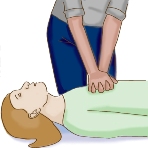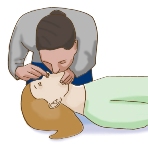Cardiopulmonary resuscitation adolescents and adults – CPR adolescents and adults
Description cardiopulmonary resuscitation adolescents and adults
Cardiopulmonary resuscitation (SLR) It is a series of action, providing assistance to a person, that no signs of life. SLR helps provide the body with oxygen, when a person is unable to do it yourself.
Indications for cardiopulmonary resuscitation
CPR procedure in the following cases:
- Sudden cardiac arrest;
- Stroke;
- Trauma;
- Suffocation;
- Sinking;
- Electric shock or lightning strike;
- Severe infection;
- Severe allergic reaction;
- Drug overdose;
- Excessive bleeding;
- Gipotermiя.
CPR results will depend on the cause and time of resuscitation. In many cases the heart after cardiac arrest is not restored and the person dies.
Possible complications during cardiopulmonary resuscitation adolescents and adults
The aim of CPR is to provide blood flow to the heart-stricken, brain and other vital organs until, as it will be provided adequate medical care. Victim, probably, dies, If CPR is not started immediately after cardiac arrest. Complications can include broken ribs, broken teeth, infection, and lung injury.
People with weakened bone system have a higher risk of bone fractures during CPR. But, there is a much greater risk of death, If CPR is started late or incorrectly made.
What to do?
Preparing for SLR
If a person does not give signs of life, you must immediately take the following steps:
- Call at the scene ambulance;
- If there is a possibility, use the defibrillator. Defibrillator – device, generates electrical pulses of high voltage, allow “run” heart-stricken.
If the person is not breathing or is choking, načinaût SLR, Doing chest compressions:
- It is necessary to lay down palm crosswise and put them on the chest of the victim;
- Start doing vigorous pressing a rate of about 100 compressions per minute;
- Allow the chest to rise completely in between pressings;
- It is necessary to minimize the breaks between contractions.

If you have the skills necessary to provide artificial ventilation:
- Get access to the airway, one hand on the forehead and lifting the chin with the other hand;
- Gently tilt the head back, close the fingers of the victim's nose and make the two deep breath into the lungs of the victim. Exhalation should be sufficient, to the chest of the victim raised. The frequency of breaths – a second.
- Having two exhalation, you need to perform 30 taps on the chest of the victim. Continue the cycle of two breaths and 30 taps.

If you do not have experience in the implementation of artificial respiration, nebhodimo keep doing chest compressions.
It is necessary to perform CPR until:
- Medical assistance does not appear;
- The victim regains consciousness and can breathe independently.
To use the defibrillator:
- You need to enable defibrillator;
- Attach pads;
- Follow the instructions on the screen. With the accumulation of charge, do electroshock. If the use is not recommended defibrillator, you must return to the cardio-pulmonary resuscitation.
How long should treatment last for cardiopulmonary resuscitation?
It is necessary to perform CPR until the arrival of the medical team, or until, until the victim has not come to his senses.
It hurts to be affected during the procedure?
The victim is unconscious, and did not feel. Some patients may complain of pain in the chest after regaining consciousness.
After the procedure.
The victim should be sent to the hospital for examination and assistance, even if it came to.
